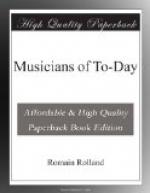This book seems to be of the Middle Ages by reason of a sort of scholastic spirit of abstraction and classification.
“In artistic creation,
seven faculties are called into play by the
soul: the Imagination,
the Affections, the Understanding, the
Intelligence, the Memory,
the Will, and the Conscience."[142]
[Footnote 142: Id., ibid., p. 13.]
And again its mediaeval spirit is shown by an extraordinary symbolism, which discovers in everything (as far as I understand it) the imprint of divine mysteries, and the mark of God in Three Persons in such things as the beating of the heart and ternary rhythms—“an admirable application of the principle of the Unity of the Trinity"![143]
From these remote times comes also M. d’Indy’s method of writing history, not by tracing facts back to laws, but by deducing, on the contrary, facts from certain great general ideas, which have once been admitted, but not proved by frequent recurrence, such as: “The origin of art is in religion"[144]—a fact which is anything but certain. From this reasoning it follows that folk-songs are derived from Gregorian chants, and not the Gregorian chants from the folk-songs—as I would sooner believe. The history of art may thus become a sort of history of the world in moral achievement. One could divide it into two parts: the world before the coming of Pride, and after it.
“Subdued by the Christian faith, that formidable enemy of man, Pride, rarely showed itself in the soul of an artist in the Middle Ages. But with the weakening of religious belief, with the spirit of the Reformation applying itself almost at the same time to every branch of human learning, we see Pride reappear, and watch its veritable Renaissance."[145]
[Footnote 143: Id., ibid., p. 25. In the thirteenth century, Philippe de Vitry, Bishop of Meaux, called triple time “perfect,” because “it hath its name from the Trinity, that is to say, from the Father, the Son, and the Holy Ghost, in whom is divine perfection.”]
[Footnote 144: Id., ibid., pp. 66, 83, and passim.]
[Footnote 145: Id., ibid.]
Finally, this Gothic spirit shows itself—in a less original way, it is true—in M. d’Indy’s religious antipathies, which, in spite of the author’s goodness of heart and great personal tolerance, constantly break out against the two faiths that are rivals to his own; and to them he attributes all the faults of art and all the vices of humanity. Each has its offence. Protestantism is made responsible for the extremes of individualism;[146] and Judaism, for the absurdities of its customs and the weakness of its moral sense.[147] I do not know which of the two is the more soundly belaboured; the second has the privilege of being so, not only in writing, but in pictures.[148] The worst of it is, these antipathies are apt to spoil the fairness of M. d’Indy’s artistic judgment. It goes without saying that the Jewish musicians are treated with scant consideration; and even the great Protestant musicians, giants in their art, do not escape rebuke. If Goudimel is mentioned, it is because he was Palestrina’s master, and his achievement of “turning the Calvinist psalms into chorales” is dismissed as being of little importance.[149]




